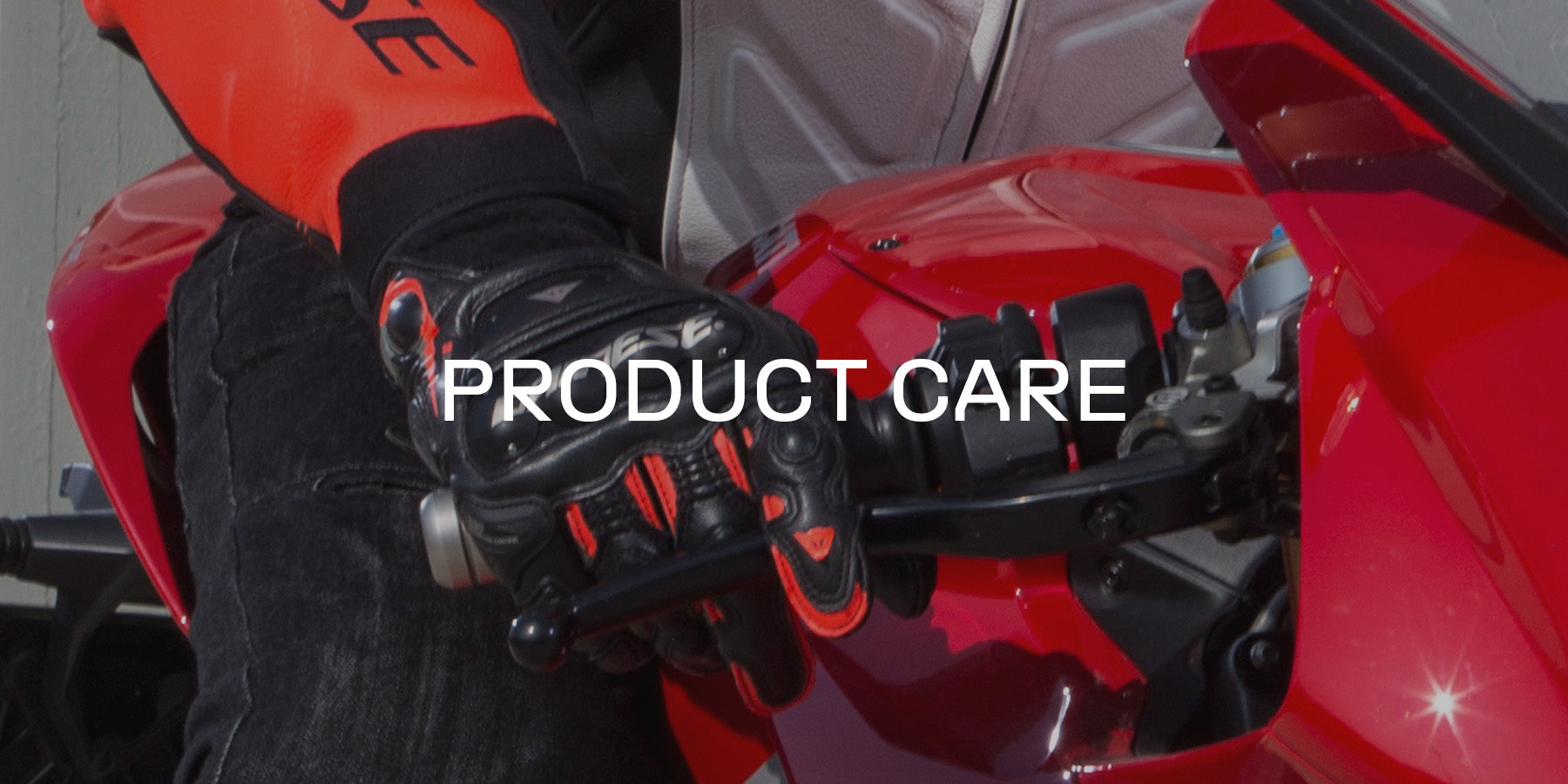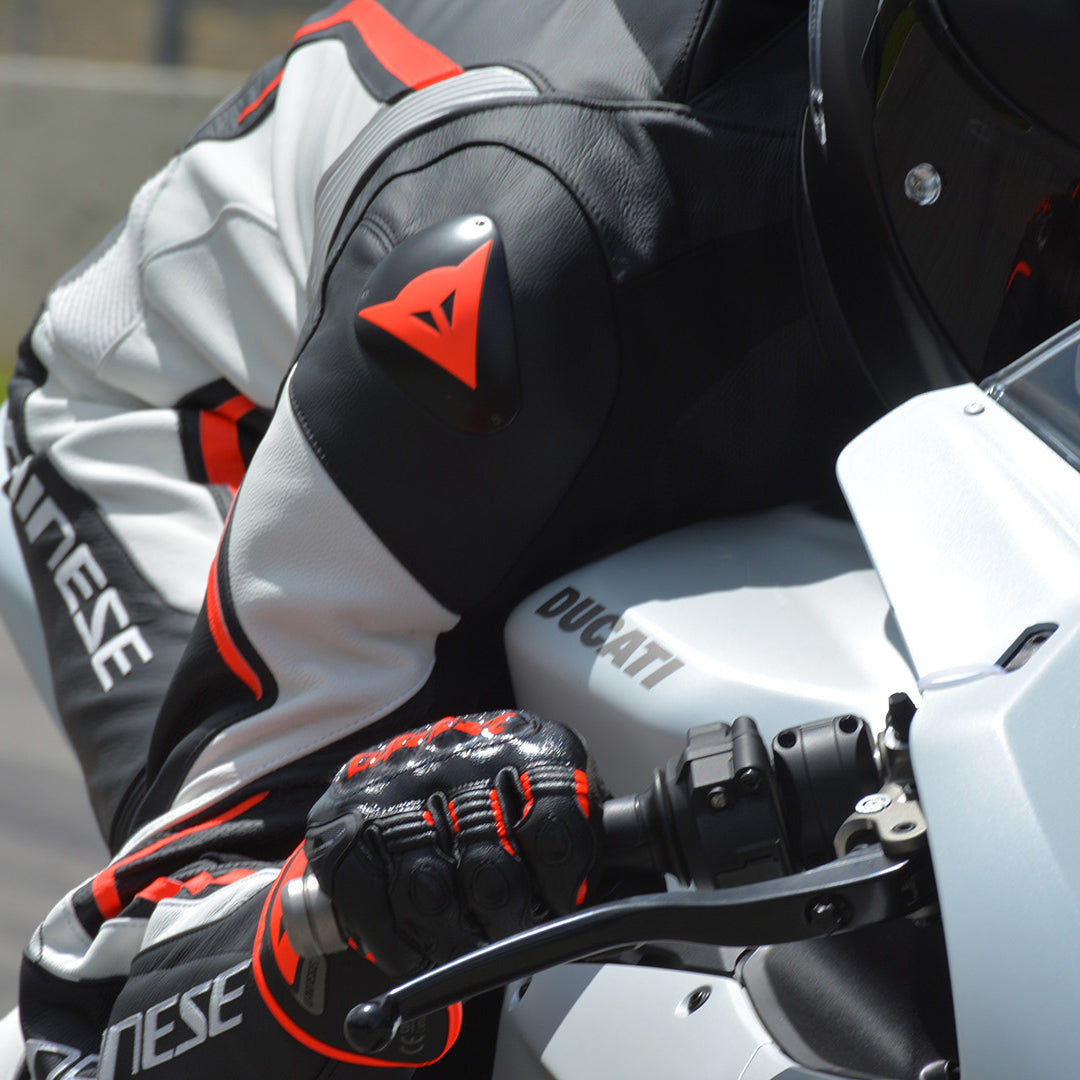The Secret to Making Your Products Last
It's important to give your garments and protective gear the love and care they deserve. By taking good care of your gear, not only can you extend its lifespan, but you can also keep it looking and feeling great!
Here are some tips for care and maintenance to help you get started:
Collapsible content
Leather Garments
It is vital not to let dirt build up over time on items of leather clothing. Never use products containing solvents to clean them. Use the Dainese “Protection & Cleaning Kit” that you can find at any Dainese store. This kit contains two products: the first is for thoroughly cleaning the hide while the second nourishes it to keep it soft and pliable.
If you don't have a kit, you can always use a sponge or a clean cloth and cold water with a little neutral soap as detergent. After cleaning the item, leave it to completely dry well away from any sources of heat (e.g. the sun, radiators, ...) and, if possible, on a flat surface or on a suitable hanger. The lining must be washed separately in water at 40°C max; Dainese recommends that you use a neutral soap and not a detergent powder which might be abrasive.
It is important to avoid dirt from building up over time on leather items. Here are some guides to clean Dainese leathers:
- Never clean your products with solvent-based cleaners.
- We recommend using the Dainese “Protection & Cleaning Kit” to treat your leather. It contains two bottles of solutions:
- Which helps in deep cleansing the leather, and
- maintaining the softness and richness of the leather.
Alternatively, you can clean the product with a sponge or a clean cloth, accompanied by some cold water and a dash of neutral soap.
Avoid direct exposure of heat and sunlight and leave it to air dry completely.
Lay the leather to dry on either a flat surface or a suitable hanger.
The lining must be washed separately in lukewarm water (not more than 40°C), with a softener free, neutral soap.
Textile Garments
It is essential that you follow instructions on the garment label.
Touring Garments
As with leather, it is important that you do not allow dirt to build up on fabric garments, which over time may seep between the weave of the fabric and become very hard to remove.
Dainese garments in fabric or with waterproof and breathable membranes such as D-Dry® o GORE TEX® should be washed in luke warm water (max. 30°C) with softener free, neutral soap, instead of detergents containing solvents and abrasives, unless otherwise indicated on the garment's label. When washing make sure you treat the outer fabric very delicately, excess rubbing may damage the fibres. It is best to remove padding and protections, close zips and Velcro's (this avoids their abrasive effect on the fabric or the internal netting).
What's more it is important to remember to dry the garment in a dry place away from direct light and heat. Remember to take great care with garments made of several different materials. In this case, always and only follow the instructions on the garment label: the indications must be strictly observed.
All technical fabrics, including elasticized versions, must always be given a very delicate cleaning treatment. In particular high-tech fibres with mechanical properties must be treated with softener free, neutral detergents.
Softeners can significantly weaken the waterproof and oil-proof surface treatments and even damage the resin coatings and multi-purpose membranes in Polyurethane and based on Polytetrafluoroethylene (i.e. PTFE – Teflon) usually applied on the backing of the fabric.
Racing Suit
To clean your Dainese Leather Suit just follow a few simple rules:
1) Do not rub down the garment with a brush or abrasive materials or creams.
2) To remove both gnats and dust, simply wipe the area with a soft sponge soaked in neutral soap and water. It is best to promptly remove any organic spots left by insects (e.g. gnats, mosquitoes etc.), since the fluids they contain are quite aggressive on the leather.
3) Any oil or grease should be washed immediately with a soft damp cloth, clean with gentle circular movements, avoiding to unduly rubbing the soiled area.
4) Dry the garment away from heat sources and in a well-ventilated place, it is best to use a clothes hanger to prevent the garment from creasing or taking on shapes that are difficult to eliminate.
5) When a garment is dried after it is accidentally wet, the leather may appear dry or stiff. To restore its initial characteristics use the Dainese Leather care KIT Protection and Cleaning Kit, which can be found at any Dainese dealer. The kit has two products: the first has an in-depth cleansing action on the leather, the second maintains it rich and soft, feeding the leather and keeping it hydrated.
The Kit can be also be used for normal cleaning and care for the garment, always when dry. Remember to take great care with garments made of several different materials. In this case, always and only follow the instructions on the garment label.
Gloves
Leather gloves are best not washed, avoiding dirt from building up over time and using the Dainese Cleaning & Protection Kit to keep them soft and clean.
Fabric gloves, in GORE-TEX® and in D-Dry®, however if a more in-depth cleaning is needed, Dainese recommends to wash them delicately in luke warm water (max. 40°C) and non-abrasive, softener free neutral soap. Then dry them in a cool, dry place, away from direct light and heat, making sure you hang them by their cuffs, with the fingertips pointing downwards. All said, only unless otherwise indicated on the garment label.
All technical fabrics, including elasticized versions, must always be given a very delicate cleaning treatment. In particular high-tech fibres with mechanical properties must be treated with softener free, neutral detergents. Softeners can significantly weaken the waterproof and oil-proof surface treatments and even damage the resin coatings and multi-purpose membranes in Polyurethane and based on Polytetrafluoroethylene (i.e. PTFE – Teflon) usually applied on the backing of the fabric.
Boots
To clean your Dainese boots just follow a few simple rules:
1) Do not rub the boots with a brush or abrasive materials and creams.
2) To remove outside dirt, simply wipe it with a soft, damp cloth, gently rubbing the surface.
3) Dry the boots away from direct heat and light, in a well-ventilated place.
4) When the boots are dried after they are accidentally wet the leather may appear dry or stiff. To restore its initial characteristics use the Dainese Leather care KIT 'Protection and Cleaning Kit', which can be found at any Dainese dealer. The kit has two products: the first has an in-depth cleansing action on the leather, the second feeds the leather, maintaining it rich and soft.
The Kit can also be used for normal cleaning and care for the boots, always when dry.
Waterproof Garments
As with leather, it is important that you do not allow dirt to build up on fabric garments, which over time may seep between the weave of the fabric and become very hard to remove. Dainese garments in fabric or with waterproof and breathable membranes such as D-Dry® o GORE TEX® should be washed in luke warm water (max. 30°C) with softener free, neutral soap, instead of detergents containing solvents and abrasives, unless otherwise indicated on the garment's label. When washing make sure you treat the outer fabric very delicately, excess rubbing may damage the fibres. It is best to remove padding and protections, close zips and Velcro's (this avoids their abrasive effect on the fabric or the internal netting). What's more it is important to remember to dry the garment in a dry place away from direct light and heat. Remember to take great care with garments made of several different materials. In this case, always and only follow the instructions on the garment label: the indications must be strictly observed. All technical fabrics, including elasticized versions, must always be given a very delicate cleaning treatment. In particular high-tech fibres with mechanical properties must be treated with softener free, neutral detergents. Softeners can significantly weaken the waterproof and oil-proof surface treatments and even damage the resin coatings and multi-purpose membranes in Polyurethane and based on Polytetrafluoroethylene (i.e. PTFE – Teflon) usually applied on the backing of the fabric.




